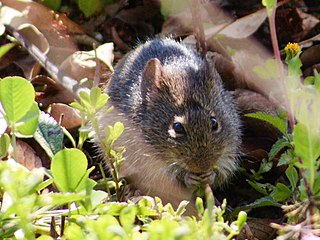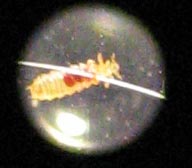
Tamias is a genus of chipmunks within the tribe Marmotini of the squirrel family. It includes a single living species, the eastern chipmunk The genus name Tamias means "treasurer", "steward", or "housekeeper", which is a reference to the animals' role in plant dispersal through their habit of collecting and storing food for winter use.

Eutamias is a genus of chipmunks within the tribe Marmotini of the squirrel family. It includes a single living species, the Siberian chipmunk. The genus is often treated as a subgenus of Tamias, which is now restricted to the eastern chipmunk of North America. Neotamias, which now includes the western North American chipmunks, has also been included in Eutamias.
Sommer's Sulawesi rat is a species of rodent in the family Muridae from Sulawesi. It is the only species in the monotypic genus Sommeromys and was described by Musser & Durden in 2002.

A cotton rat is any member of the rodent genus Sigmodon. Cotton rats have small ears and dark coats, and are found in North and South America. Members of this genus are distributed in the Southwestern United States, Mexico, Central America, and South American countries of: Venezuela, Ecuador, Colombia, Peru, Brazil, Guyana, and Suriname. Many of the species are found in Mexico.
Rheomys raptor, also known as the Goldman's water mouse or Goldman's Ichthyomyine, is a species of rodent in the family Cricetidae. This mouse is semiaquatic and its carnivorous diet includes invertebrates. The conservation status of the species is rated as "least concern" because of its sizable population and the presence of several protected areas within its range. However, deforestation and water pollution represent potential threats.
Allen's cotton rat is a species of rodent in the family Cricetidae. It is endemic to western Mexico, where its distribution extends from Sinaloa to Oaxaca. The formerly recognized S. planifrons and S. vulcani are now considered conspecific with S. alleni by the IUCN.
The unexpected cotton rat is a species of rodent in the family Cricetidae. It is found only in Ecuador at elevations of 3500 to 4000 m, where it has been found in association with streams and marshes. It is also known as the Ecuadorian cotton rat.
The white-eared cotton rat is a species of rodent in the family Cricetidae. It is found only in Mexico.
The Peruvian cotton rat is a species of rodent in the family Cricetidae. It is found in Ecuador and Peru.

The southern cotton rat is a rodent species in the family Cricetidae. It is found from southern Chiapas in Mexico through Central America, except for Belize, and as far east as northern Colombia and Venezuela. It lives in tropical rainforest, dry forest and savanna, as well as in cultivated areas. The species is terrestrial and primarily diurnal. It was long thought to be a subspecies of S. hispidus. However, recent taxonomic revisions, based on mitochondrial DNA sequence data, have split the extensive former species range into three separate species. Carroll et al. (2004) indicate that the southern edge of the S. hispidus distribution is likely near the Rio Grande where it meets the northern distribution of S. toltecus. The range of S. toltecus extends from northern Mexico south into Chiapas where it occurs in sympatry with S. hirsutus . Rats from this species group have been used as laboratory animals.
The Miahuatlán cotton rat was formerly considered a rodent species in the family Cricetidae. It is found only on the Pacific slope of the Sierra de Miahuatlán in the Mexican state of Oaxaca, where it lives in deciduous tropical forest. The IUCN currently considers it to be conspecific with Sigmodon alleni.

Polyplax spinulosa is a sucking louse (Anoplura) from the genus Polyplax. It occurs worldwide and commonly infects its type host, the brown rat, and related species like the black rat, Rattus pyctoris, Rattus nitidus, Rattus argentiventer, Rattus tanezumi, Rattus exulans, and Bandicota indica. It is also occasionally found in other rodents, such as the marsh rice rat in North America.
Hoplopleura oryzomydis is a sucking louse that is known from the southern United States, Nicaragua, Panama, and Venezuela. It is known from several oryzomyine rodents: the marsh rice rat, O. couesi, Handleyomys alfaroi, Transandinomys talamancae, Melanomys caliginosus, and Sigmodontomys alfari.
Ctenophthalmus pseudagyrtes is a species of fleas in the family Hystrichopsyllidae. It is widespread in North America, east of the Rocky Mountains, and is found mainly on small mammals. In Missouri, it has been recorded on the Virginia opossum, northern short-tailed shrew, eastern mole, raccoon, eastern chipmunk, Florida woodrat, prairie vole, woodland vole, white-footed mouse, including nests, marsh rice rat, hispid cotton rat, house mouse, and brown rat. Hosts recorded in Tennessee include the Virginia opossum, northern short-tailed shrew, eastern mole, eastern chipmunk, southern red-backed vole, rock vole, woodland vole, white-footed mouse, golden mouse, hispid cotton rat, marsh rice rat, and house mouse.
Stenoponia americana is a species of large flea in the family Hystrichopsyllidae. It is widespread in North America east of the Great Plains and is found mainly on rodents, notably deermice (Peromyscus) and voles (Microtus). In Missouri, it has been recorded on the fox squirrel, brush mouse, cotton mouse, prairie vole, woodland vole, and white-footed mouse. Hosts recorded in Tennessee include the northern short-tailed shrew, woodland vole, white-footed mouse, hispid cotton rat, marsh rice rat, and house mouse. In South Carolina, recorded hosts include the cotton mouse, hispid cotton rat, and marsh rice rat.
Polygenis gwyni is a flea that commonly infects the hispid cotton rat in the southern United States; it is also frequently found on other species ecologically associated with the cotton rat. Hosts recorded in South Carolina include the cotton rat as well as the Florida woodrat, cotton mouse, marsh rice rat, and brown rat.

Neotamias is a genus of chipmunks within the tribe Marmotini of the squirrel family. It contains 23 species, which mostly occur in western North America. Along with Eutamias, this genus is often considered a subgenus of Tamias.

Amblyomma maculatum is a species of tick in the genus Amblyomma. Immatures usually infest small mammals and birds that dwell on the ground; cotton rats may be particularly favored hosts. Some recorded hosts include:
Eutrombicula batatas is a species of chigger.






